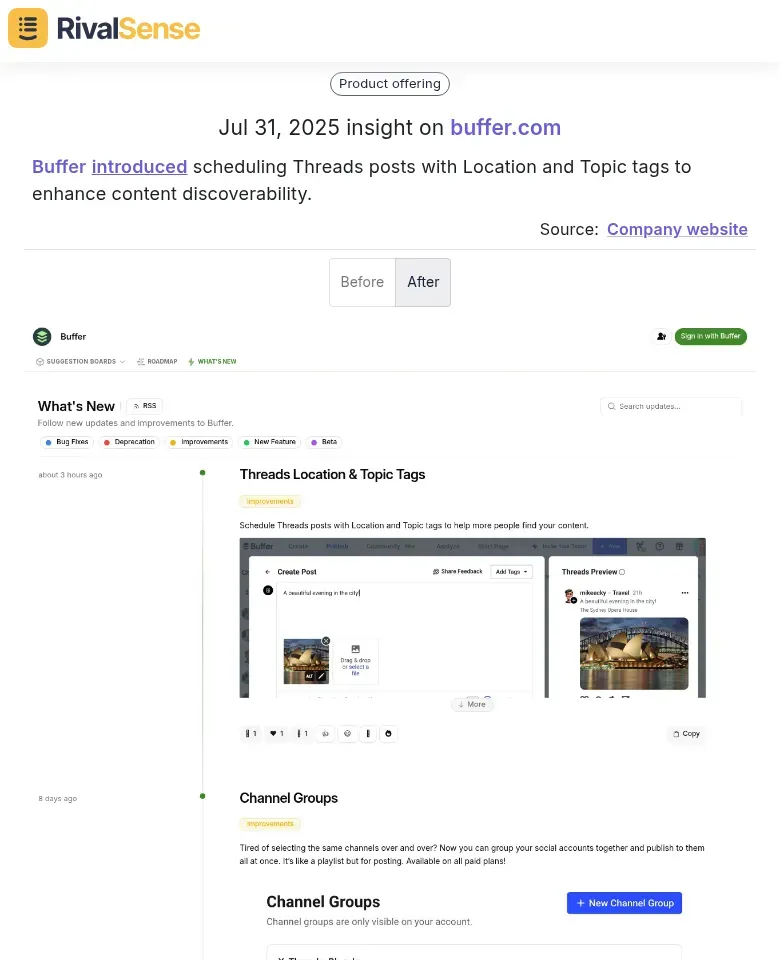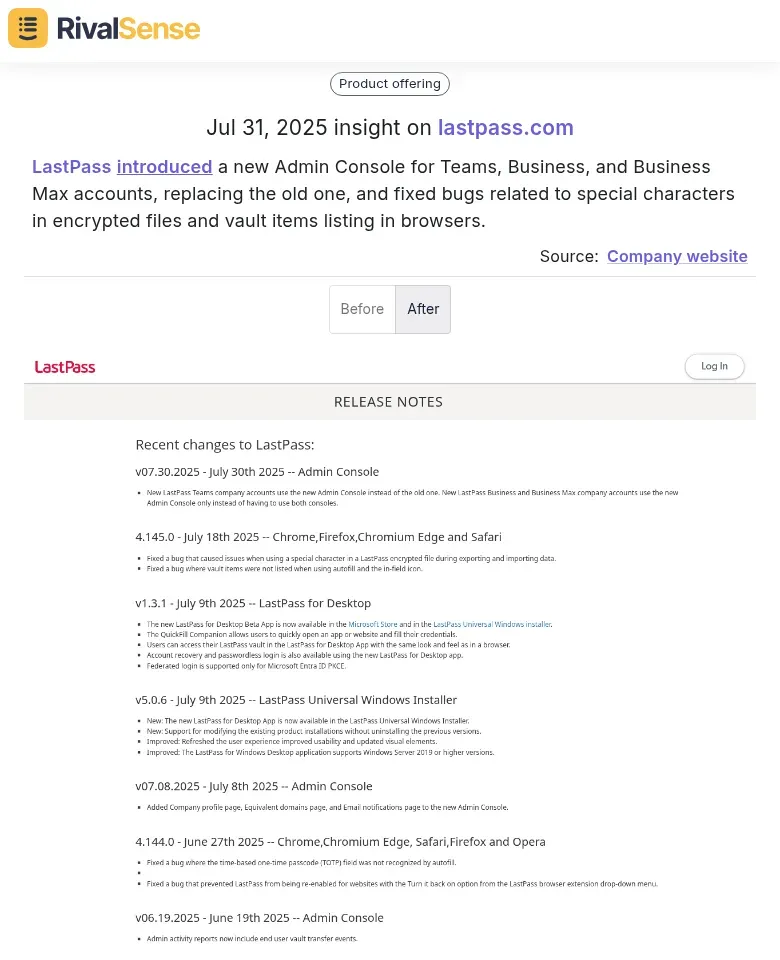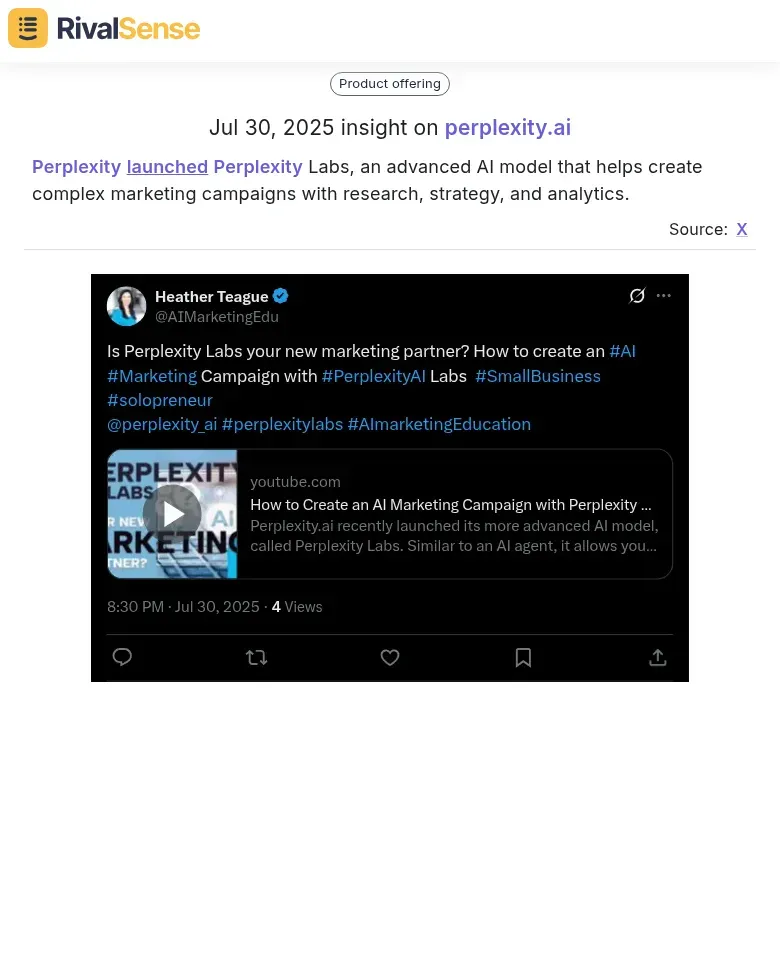Competitor Product Insights: A Strategic Tool for Boosting Analyst Relations
In today's fast-paced B2B markets, maintaining competitive advantage requires more than just monitoring your own product roadmap—it demands deep awareness of rival movements. Competitor product insights reveal market gaps, emerging trends, and potential threats before they impact your business. By systematically tracking competitor updates, you can anticipate industry shifts and strategically position your offerings.
Analyst relations (AR) thrives on these insights. Industry analysts value companies demonstrating comprehensive market understanding, including competitor strategies. Sharing well-researched competitor intelligence during briefings enhances credibility, influences reports, and positions your brand as a thought leader. For instance, showcasing how your solution addresses a competitor's feature gap creates compelling narratives for analyst conversations.
In this post, we’ll explore:
- Feature Comparisons: Benchmarking strengths/weaknesses against rivals
- Pricing Strategies: Refining your models using competitor data
- Customer Feedback: Mining competitor reviews for unmet needs
- Roadmap Clues: Predicting market shifts from rival announcements
Actionable Starting Points:
- ✅ Automate tracking with specialized tools
- ✅ Schedule weekly competitor update reviews
- ✅ Create monitoring checklists (features, pricing, UX)
- ✅ Share findings with AR teams pre-briefing
Enhancing Content Discoverability Through Competitor Analysis
Analyzing competitors' content strategies provides invaluable visibility optimization lessons. Notice how industry leaders leverage scheduling patterns, metadata, and categorization to boost engagement—these tactics often reveal untapped opportunities for your brand. Consistently auditing rival approaches helps identify high-performing formats and SEO techniques worth emulating or improving upon.
Metadata optimization and thematic categorization significantly impact discoverability. Examine competitors' keyword strategies in meta titles/descriptions and their content grouping logic (by topic, industry, or audience segment). These elements directly influence search rankings and user navigation—critical factors for analyst-facing content where credibility is paramount.
Real-World Insight:

Buffer's Threads scheduling with location/topic tags demonstrates how competitor feature updates can inspire your content strategy. Tracking such innovations helps uncover new discoverability tactics before they become industry standards.
Implementation Framework:
- Audit Top-Performing Rival Content: Document their scheduling cadence, tags, and metadata
- Optimize Metadata: Integrate high-value keywords into your titles/descriptions
- Revamp Categorization: Group content by strategic themes (e.g., "Analyst Relations Tactics")
- Test & Measure: Pilot new approaches and track engagement lift
Streamlining User Experience with Product Updates
User experience (UX) optimizations directly impact customer retention and analyst perceptions. Prioritize UI simplifications—streamline navigation, enhance visual clarity, and ensure intuitive workflows. Simultaneously, address technical debt: resolving bugs and performance issues demonstrates commitment to reliability, a key analyst evaluation metric.
Effectively communicating UX improvements amplifies their AR value. Develop concise update logs highlighting user benefits, then showcase them during analyst briefings with supporting metrics. For example, present before/after satisfaction scores or efficiency gains to tangibly demonstrate your product's evolution.
Real-World Insight:

LastPass' admin console overhaul shows how monitoring competitor UX updates provides actionable benchmarks. Tracking such enhancements helps identify industry UX standards and reveals opportunities to differentiate through superior design.
Execution Checklist:
▢ Conduct user testing to identify critical pain points
▢ Prioritize updates by impact/feasibility (e.g., high-traffic page fixes first)
▢ Implement staged rollouts with control groups
▢ Create visual changelogs for analysts (before/after screenshots)
▢ Quantify improvements: "Reduced setup time by 40%"
Leveraging Advanced AI for Marketing Campaigns
Artificial intelligence transforms marketing through hyper-personalization and predictive analytics. AI tools automate audience segmentation, content optimization, and performance forecasting—freeing teams for strategic initiatives. More importantly, they generate campaign insights that resonate powerfully during analyst presentations.
Competitor AI implementations offer invaluable innovation blueprints. Monitoring rival machine-learning applications reveals emerging best practices and gaps your solutions can fill. This intelligence becomes crucial when discussing technological differentiation with analysts.
Real-World Insight:

Perplexity's AI campaign tools illustrate how tracking competitor tech launches informs strategic planning. Such insights help anticipate market shifts and position your AI capabilities as industry-leading during analyst evaluations.
AI Integration Roadmap:
| Step | Action | AR Benefit |
|---|---|---|
| 1. | Identify automatable tasks (e.g., report generation) | Frees AR time for strategic engagement |
| 2. | Pilot AI chatbots for analyst Q&A | Demonstrates tech-forward positioning |
| 3. | Analyze competitor AI models for differentiation angles | Provides compelling briefing narratives |
| 4. | Showcase AI-driven campaign results | Validates innovation claims with data |
Applying Competitor Insights to Analyst Relations
Competitor intelligence transforms AR from reactive to strategic. When you contextualize your product decisions against rival movements, analysts perceive deeper market understanding—strengthening relationships and report influence. Crucially, this positions your team as indispensable industry authorities rather than product promoters.
Structure insights to highlight your differentiators during briefings. For example, contrast your recent UX overhaul against competitors' unresolved pain points, using third-party review data as evidence. This evidence-based approach makes competitive advantages undeniable.
AR Presentation Protocol:
- Lead with objectivity: Present neutral competitor data before your interpretation
- Visualize comparisons: Use tables/charts to show feature/pricing differentials
- Tailor to specialties: Focus on cybersecurity trends for infosec analysts
- Connect to macro trends: Frame insights within industry movements (e.g., "As SaaS consolidation accelerates...")
Briefing Preparation Kit:
- 📊 Current competitor feature matrix
- 💰 Comparative pricing analysis
- 🗣️ Customer sentiment snapshots (G2/Trustpilot)
- 📈 Adoption metrics for your recent updates
Conclusion and Next Steps
Competitor product intelligence is the catalyst for elevated analyst relations and sustained market relevance. By systematically tracking feature developments, pricing shifts, and UX innovations, you gain the contextual awareness needed to position your offerings as category leaders. More importantly, this intelligence transforms analyst conversations from feature demonstrations to strategic dialogues about industry evolution.
Sustainable Monitoring Framework:
- Set automated alerts for competitor website/social updates
- Dedicate 15 minutes daily to reviewing competitive movements
- Integrate findings into monthly strategy sessions
- Develop "competitive response playbooks" for common scenarios
Turn insights into action today: Try RivalSense Free to automate competitor tracking across product launches, pricing changes, and feature updates. Get your first customized competitor report delivered instantly—no waiting periods.
📚 Read more
👉 Decoding Competitor Moves: Martian's New Code Platform
👉 Automated Competitive Analysis Tools: The Ultimate Guide for 2025
👉 How to Leverage Strategic Market Intelligence in Accounting
👉 How Oliver Bonas' Beauty Expansion Strategy Can Inspire Your Competitive Edge
👉 Unlock Competitive Edge: Mastering Twitter Competitor Insights
